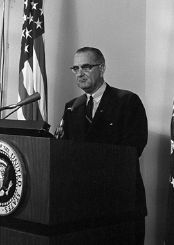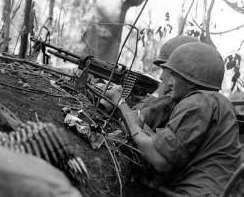 The Gulf of Tonkin and
the Vietnam War
The Gulf of Tonkin and
the Vietnam War
“In the summer of 1964, President Lyndon Baines Johnson needed a pretext to
commit the American people to the already expanding covert war in South East
Asia.
In November of 2001, the LBJ Presidential library and museum released
tapes of phone conversations with the President and then Defense Secretary
Robert McNamara where they openly discussed plans to use the staged Gulf of
Tonkin incident as a pretext to expand the war.”
Alex Jones, “Terrorstorm”
(12mins)
On August 2nd, 1964, the USS Maddox destroyer was supposedly conducting
reconnaissance in the Gulf of Tonkin when fired upon by North Vietnamese
forces in Swatow gunboats.
The Maddox, however, was not on a reconnaissance
mission; it was part of a joint CIA-South Vietnamese covert intelligence
operation called 'Operation Plan 34A.'
“Far from being an ‘unprovoked attack’ as President Lyndon Johnson had
stated, the attack was an expected retaliation as a result of aggressive
CIA-South Vietnamese maneuvers.
Johnson himself acknowledged Operation Plan
34A in recently released White House tape recordings, ‘There have been some
covert operations in that (Tonkin Gulf) area that we have been carrying on
blowing up some bridges and things of that kind, roads and so forth.
So I
imagine (the North Vietnamese) wanted to put a stop to it.’”
Paul Joseph
Watson, “Order Out of Chaos” (27)
Once again the people were manipulated into believing
a
false flag
reason for entering the Vietnam War.
This time the public was told a
friendly ship came under unprovoked enemy attack, when in fact our ship was
the aggressor.
“In late 2005, the National Security Agency declassified its own official
history of the Gulf of Tonkin and admitted that intelligence agency officers
had deliberately skewed the intelligence and claimed that Vietnamese patrol
boats had attacked US Destroyers on Aug. 4th, 1964, when in reality they had
done nothing even while being fired on by US forces.”
Alex Jones,
“Terrorstorm” DVD (12 mins.)

On August 4th, 1964, the US Destroyers received radar and radio signals that
were misinterpreted as being another enemy attack from the North Vietnamese
navy.
Supposedly a two-hour shootout ensued, but in reality there were likely
no enemy ships out there.
An hour after the incident, Captain John J.
Herrick of the USS Maddox, sent a cable admitting the attack may not have
been an attack after all.
“Review of action makes many reported contacts and torpedoes fired appear
doubtful. Freak weather effects on radar and overeager sonar men may have
accounted for many reports. No actual visual sightings by Maddox. Suggest
complete evaluation before any further action taken.”
Captain John J.
Herrick, Aug.
4th, 1964
"I had the best seat in the house to watch that event, and our destroyers
were just shooting at phantom targets there were no PT boats there. There
was nothing but black water and American firepower.”
Naval Aviator James
Stockdale, from his 1984 book

With no justification whatsoever, on the evening of August 4th,
Johnson
stated,
“the initial attack on the destroyer Maddox, on August 2nd, was
repeated today by a number of hostile vessels.”
Actually no US ships were
fired upon, and there were likely no Vietnamese boats present either, but
Johnson reported,
“We believe at least two of the attacking boats were
sunk.”
Later on, however, in 1965 Johnson was quoted referring to the Tonkin
incident admitting,
“For all I know, our Navy was shooting at whales out
there.”
“The Vietnam War killed one million Vietnamese and 58,000 Americans. It was
launched after two incidents in August 1964, the first of which was provoked
and the second never happened.
With careful avoidance of the facts, then
President Lyndon Baines Johnson was able to ram through the Gulf of Tonkin
resolution, denouncing those who raised suspicious voices as anti-American,
and receiving a validation for war.”
Paul Joseph Watson, Order Out of Chaos
(26)
Back to Contents
 The Gulf of Tonkin and
the Vietnam War
The Gulf of Tonkin and
the Vietnam War

